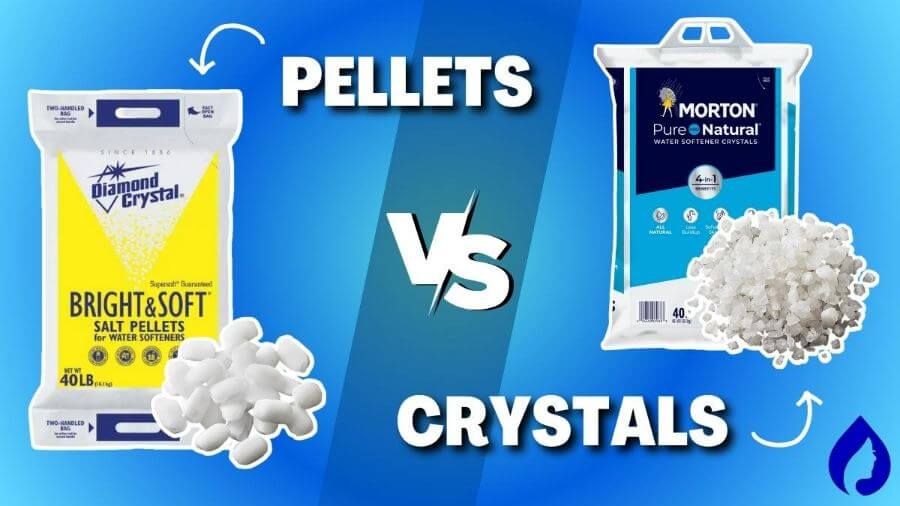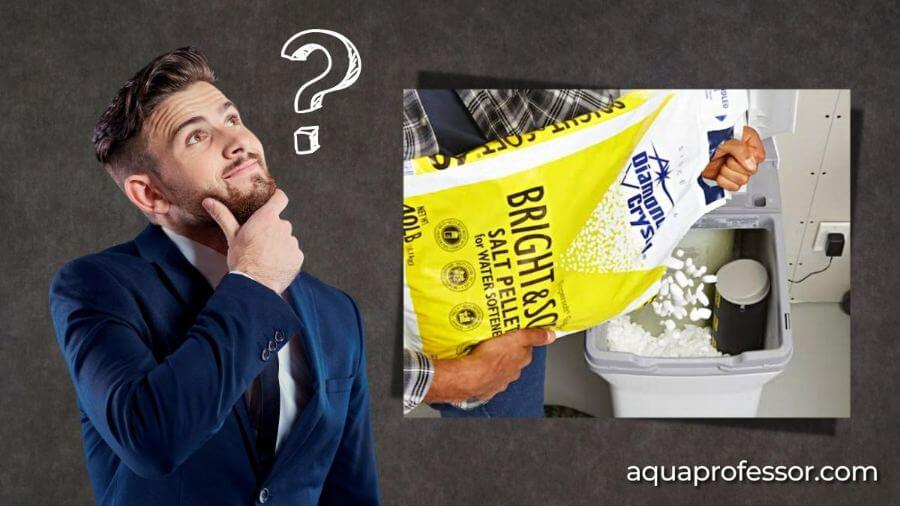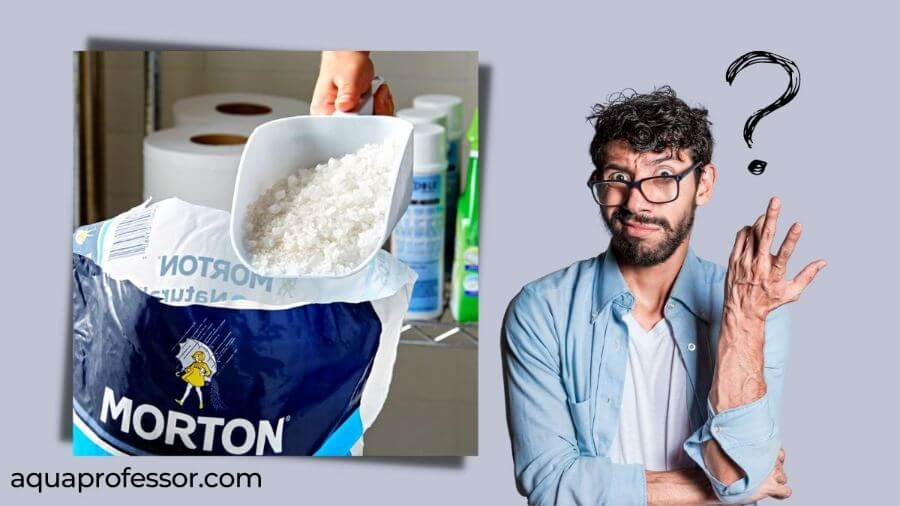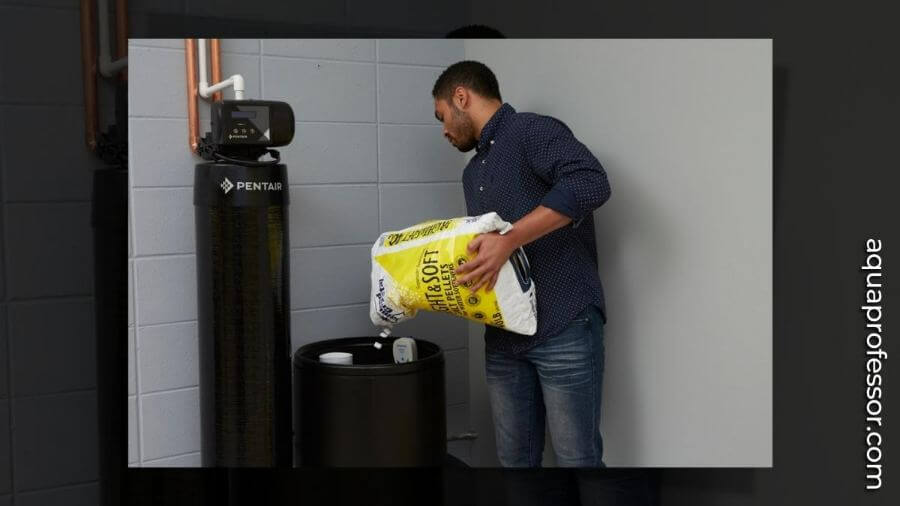
The most popular softener salt types are crystals and pellets. But what’s the difference between the two? Which one is better?
Pellets are best for all-in-one water softener systems with high water use, whereas crystals are best for two-part softeners with low water usage.
Continue reading for a detailed difference between water softener pellets vs crystals so you can enjoy softer water without hassle.
🤔Is It Better to Use Water Softener Pellets or Crystals?
| Basis | Softener Pellets | Softener Crystals |
| Softening Efficiency | High | Moderate |
| Maintenance | Low | Moderate |
| Cost | Expensive | Less expensive than pellets |
| Best For: | All-in-one softeners | Two-part softeners |
🔎Are Water Softener Pellets Better?

Softener pellets are created by compressing salt into compact forms, resulting in dense and durable pellets. These pellets are best suited for all-in-one softeners.
Now, let’s explore the pros and cons of using water softener pellets:
Pros and Cons of Softener Salt Pellets
Pros
- No Salt Bridging: Softener pellets are less prone to salt bridging, a common issue where a hard crust forms on top of the salt in the brine tank. It ensures a consistent supply of brine, maintaining the efficiency of the softening process.
- Less Maintenance: Softener pellets generally require less maintenance than other salt forms. Their compact shape and slow dissolution rate contribute to reduced refill and regeneration cycles, making them convenient for busy households.
- Suitable for High Water Use: With their high softening efficiency, softener pellets are ideal for households with high water usage. Whether you have a large family or frequently entertain guests, these pellets can handle the demand, ensuring consistently soft water throughout.
Cons
- Expensive: One drawback of softener pellets is their relatively higher cost than other salt types. The pellets’ manufacturing process and compact nature contribute to their higher price point.
Also Read: Can You Use Pool Salt In Water Softener?
👀Are Water Salt Crystals Worth It?

Softener crystals are formed through the natural evaporation of brine, salt, and water, resulting in crystalline salt structures.
These crystals dissolve quickly and are well-suited for two-part softeners utilizing separate brine and mineral tanks.
Now, let’s explore the pros and cons of using water-softener crystals:
Pros and Cons of Softener Crystals
Pros
- Budget-Friendly: Softener crystals offer a cost-effective solution for water softening, making them an affordable choice.
Cons
- Prone to Salt Bridging: Softener crystals are susceptible to salt bridging, where a hardened crust forms on top of the salt in the brine tank, potentially affecting their performance.
- High Maintenance: Softener crystals require regular maintenance, including refills and regeneration cycles, to ensure optimal water softening.
- Not Ideal for High Water Usage: Softener crystals may not be the best option for households with high water consumption, as their slow dissolution rate and compact composition may struggle to meet the demand.
Also Read: Can You Use Softener Salt To Melt Ice?
🤷Does It Matter if I Use Water Softener Pellets or Crystals?

When choosing between water softener pellets and crystals, it’s important to consider the type of softener you have, your water usage, and the manufacturer’s instructions.
It’s important to note that while softener pellets offer numerous benefits, they can be more expensive compared to crystals. However, their benefits, such as resistance to salt bridging and lower maintenance requirements, outweigh the additional expense.
Also Read: Is It Safe To Use Softener Salt To Kill Weed?
👨🏫Water Softener Pellets VS Crystals: FAQs
Can I mix pellets and crystals in my water softener?
Mixing pellets and crystals in a water softener is generally not recommended, as they have different dissolution rates and can lead to inconsistent performance.
Is water softener crystals the same as pellets?
No, water softener crystals and pellets are different forms of salt used in water softeners. Crystals are larger and dissolve faster hence not suited for high water usage, while pellets are denser and dissolve slower, making them the best alternative overall.
What is the cheapest water softener salt?
Rock salt is often considered the cheapest option for water softener salt, but it may contain impurities that can affect the performance and lifespan of the softener.
What type of salt is best for a water softener?
Evaporated salt is considered the best type for water softeners due to its high purity and easy solubility. It leaves minimal residue in the salt tank and effectively aids regeneration. While other salt types exist, like rock salt and salt crystals, evaporated salt’s superior quality and efficiency make it a preferred choice for optimal water-softening results.
How much water softener salt should I use?
As a general rule, you should add 1 pound of salt for every 100 gallons of water that requires softening. However, actual usage may vary based on water hardness, household size, and water consumption patterns. For precise guidance, refer to the manufacturer’s instructions in the softener manual or customer care.
Adarsh is a Health & Nutrition Sciences graduate with expertise in environmental health. He is associated with ventures like Glacier Fresh Filter and Simpure Filter Systems. Through Aqua Professor, he intends to provide helpful information to every home to help them make smarter decisions.
